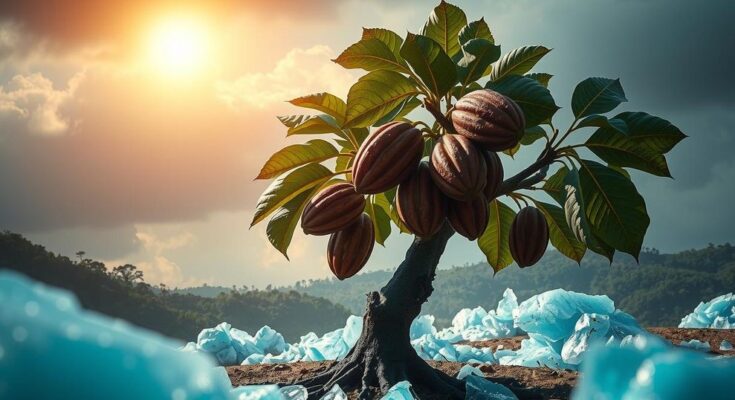Valentine’s Day spending on chocolate is expected to rise, yet cocoa production is increasingly threatened by climate change, resulting in decreased yields and soaring prices. Cacao trees rely on specific climate conditions, which are becoming less stable due to global warming. Adaptation strategies exist, and consumer choices can support sustainable farming practices, emphasizing the importance of ethical sourcing.
Valentine’s Day spending is expected to reach over $27.5 billion in 2024, with approximately 11.2% of that allocation dedicated to chocolate. Americans consume around 58 million pounds of chocolate during this celebration. However, cocoa production faces challenges due to climate change, which has implications on both availability and pricing in the chocolate market. Jessica Fanzo, a climate professor, highlights how cacao trees flourish under specific conditions which are increasingly affected by global warming.
The main regions for cocoa production include West Africa, Southeast Asia, and parts of Central and South America. Cacao trees, which thrive in tropical climates, require warm temperatures, high humidity, and consistent rainfall to yield cocoa pods effectively. Climate variability poses a significant threat, as cacao trees take years to reach peak productivity while climate change accelerates adverse conditions.
Changes in weather patterns, including droughts and excessive rainfall, are diminishing cocoa yields. Water stress from inconsistent rainfall, coupled with high temperatures leading to soil moisture loss, significantly impacts crop viability. Areas in West Africa face severe climatic shifts, complicating the traditional cultivation methods for cacao trees and risking both human nutrition and industry sustainability.
Adaptation strategies are available for cocoa farmers, such as utilizing drought-resistant and disease-resistant cocoa varieties, experimented with in locations like Ghana and Brazil. Mixed agroforestry systems may also be implemented to provide shade and maintain soil moisture. Moreover, proper soil and water management practices, including mulching and rainwater harvesting, are essential to sustaining cocoa production amid changing climates.
Consumers can encourage more sustainable chocolate production by choosing certified products that favor ethical sourcing and environmentally friendly practices. Companies that obtain sustainability certifications often pursue fair labor and wages for farmers. The chocolate market includes various options, necessitating consumer research into sourcing practices and advocacy for policies supporting fair trade and climate change mitigation.
Current cocoa prices are escalating, attributed to low yields in key producing regions like Cote D’Ivoire and Ghana, as well as diseases affecting crops. A dramatic increase of more than 300% in cocoa prices over the last two years reflects the impact of climate-induced challenges alongside market dynamics like speculation and delayed yield recovery from new tree planting.
In summary, climate change is critically impacting cocoa production, which is vital for the chocolate industry. As global warming affects agricultural conditions, cocoa prices are rising, with significant consequences for both farmers and consumers. Adaptation strategies and consumer choices play important roles in this complex issue, emphasizing the need for sustainable practices within the chocolate market.
Original Source: news.climate.columbia.edu




